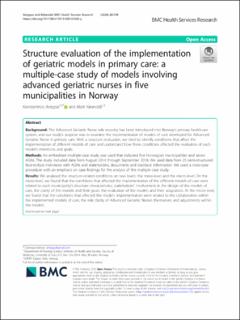| dc.contributor.author | Antypas, Konstantinos | |
| dc.contributor.author | Kirkevold, Marit | |
| dc.date.accessioned | 2023-08-16T13:50:06Z | |
| dc.date.available | 2023-08-16T13:50:06Z | |
| dc.date.created | 2020-11-06T11:34:03Z | |
| dc.date.issued | 2020 | |
| dc.identifier.citation | BMC Health Services Research. 2020, 20, 749. | en_US |
| dc.identifier.issn | 1472-6963 | |
| dc.identifier.uri | https://hdl.handle.net/11250/3084441 | |
| dc.description.abstract | Background: The Advanced Geriatric Nurse role recently has been introduced into Norway’s primary healthcare system, and our study’s purpose was to examine the implementation of models of care developed for Advanced Geriatric Nurse in primary care. With a structure evaluation, we tried to identify conditions that affect the implementation of different models of care and understand how these conditions affected the realisation of each model’s intentions and goals.
Methods: An embedded multiple-case study was used that included five Norwegian municipalities and seven AGNs. The study included data from August 2014 through September 2018. We used data from 25 semi-structured face-to-face interviews with AGNs and stakeholders, documents and statistical information. We used a cross-case procedure with an emphasis on case findings for the analysis of the multiple case study.
Results: We analysed the structure-related conditions on two levels: the meso-level and the micro-level. On the meso-level, we found that the conditions that affected the implementation of the different models of care were related to each municipality’s structure characteristics, stakeholders’ involvement in the design of the models of care, the clarity of the models and their goals, the evaluation of the models and their adaptation. At the micro-level, we found that the conditions that affected the models’ implementation were related to the collaboration within the implemented models of care, the role clarity of Advanced Geriatric Nurses themselves and adjustments within the models.
Conclusions: The implementation of the AGN role in Norway seems to have been implemented in ways that can impact patients and municipalities positively. Potential improvements include extensive stakeholder involvement, improved roles, goal clarity and better documentation of structures and outcomes. The models’ dynamic nature seemed to be a beneficial characteristic, but adaptation should be systematic and a necessary time should be considered for a new model of care to be integrated and produce results. | en_US |
| dc.language.iso | eng | en_US |
| dc.publisher | BMC | en_US |
| dc.rights | Navngivelse 4.0 Internasjonal | * |
| dc.rights.uri | http://creativecommons.org/licenses/by/4.0/deed.no | * |
| dc.title | Structure evaluation of the implementation of geriatric models in primary care: A multiple-case study of models involving advanced geriatric nurses in five municipalities in Norway | en_US |
| dc.type | Peer reviewed | en_US |
| dc.type | Journal article | en_US |
| dc.description.version | publishedVersion | en_US |
| dc.rights.holder | © The Author(s) 2020 | en_US |
| dc.source.volume | 20 | en_US |
| dc.source.journal | BMC Health Services Research | en_US |
| dc.identifier.doi | 10.1186/s12913-020-05566-y | |
| dc.identifier.cristin | 1845568 | |
| dc.relation.project | Norges forskningsråd: 239766 | en_US |
| dc.source.articlenumber | 749 | en_US |
| cristin.ispublished | true | |
| cristin.fulltext | original | |
| cristin.qualitycode | 2 | |

